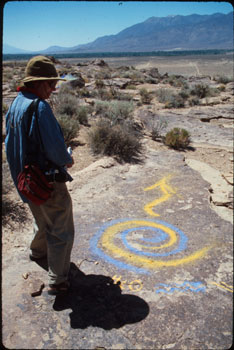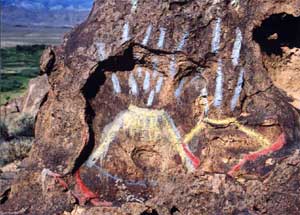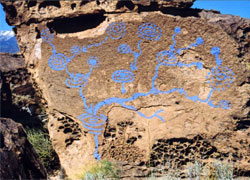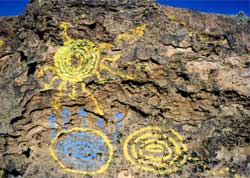Global Warming
 |
I had a lot of chalk and pastels at home, so I brought them with me. I remembered the nice cliffs of Bishop Tuff, with their clean joint-bounded vertical faces along the mouth of the Owens Gorge. I thought they might be good to write on. But it was difficult to write on rough rock with chalk, and even the smooth joint faces were rough. I found that wetting the vertical rock faces helped, and so did smearing the chalk with a wet paintbrush. Powdered chalk from hardware stores works pretty good mixed with a bit of water. I had to watch for drips. It's tricky. I decided to paint a series of scenes using only figures and symbols. It ended up being a doomsday story about the geologic history of the region, the ice ages, the coming of man and global warming. Someone commented that it was very professorial-a lecture with a chalkboard, it turns out that its very difficult to break away from who you are. |
 |
1. At about 760,000 years ago, the Long Valley Caldera formed when the Bishop Ash Flow Tuff was erupted. Airborne ash from this eruption made it halfway across the country to Kansas and Nebraska. Owen's Valley was devastated and deeply covered with volcanic debris. |
 |
2. At about 18,000 to 20,000 years ago, the last ice age was in full swing. Glaciers helped sculp the valleys and high topography of the Sierra Nevada, possibly for the last time. There was plenty of water and lakes filled all of the valleys of the Basin and Range. Water flowed from the high Sierra through a consecutive series of interconnected lakes all the way to Death Valley which was filled with 500-700 feet of water, and formed the longest lake of them all. |
 |
3. The tail end of the ice age came about 10,000 or so years ago. Glaciers melted. The warmer climate and abundant water fostered the migration of the first humans into the region. The first fossil-fuel burners on the planet, ever. It wasn't so tricky to kill those big hairy beasts that grazed and roamed the land, all it took was special spears. Fire was important to keep warm and meat was better cooked than raw. |
 |
4. The climate continued to warm. Eventually the rate of evaporation exceeded the supply of water to the large intermontane lakes of the Great Basin. The water in these lakes became saline and fitfully and slowly they dried up, becoming the playas of today. |
5. Based on detailed records from sediments and ice cores, scientists know that glacial-interglacial episodes last an average of 8,000-10,000 years. We are now right in the middle of an interglacial episode. Will the earth cool off again as we head into the next predicted ice age? There are multiple factors at work on the earth that interact and become the "triggers" for the global cooling episodes that characterize the Pleistocene ice ages. But we don't understand how these factors work together and interact to produce rapid climate change. We know that the climate is warming at a rapid rate since the beginning of the industrial era related to our continued increased use of fossil fuel and generation of greenhouse gases. Have we pushed things too far? Have we succeeded in altering the climate of the earth at the geologic time scale?